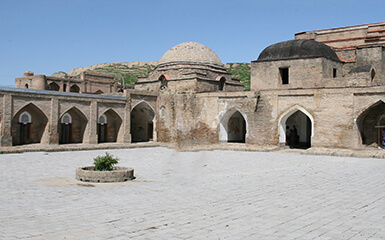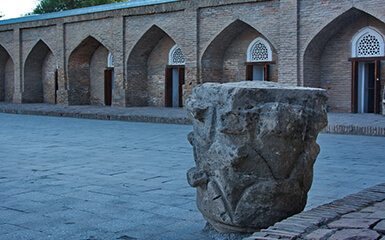Kok Gumbaz
Ajina Teppa
Ancient Panjakent
Anzob Tunnel
Beshkent Qala
Childukhtaron
Khazrati Shokh
Mug Teppa
Gharm Chashma
Hisor Historical
Haji Yaqub mosque
Hazrati-Bobo complex
Lake Iskanderkul
Kalai-Khumb
Karatag
Karon
Khishtin caravanserai
Khorog
Khulbuk
Lake Karakul
Abdullatif Sultan
Madrasai Kuhna
Abu Abdullah Rudaki
Khoja Mashhad
Khudoyor Valami
Makhmudi Azam
Mir Sayyid Ali Hamadani
Muhammed Bashoro
Sheikh Muslihiddin
Nurek Mountain Lake
Pamir
Sarazm
Sari-Khosor
Seven Lakes
Shirkent
Chiluchorchashma
Takht-i Sangin
Madrasai Kuhna – the old madrasah

The building of the educational institution of the Muslim East (XVI-XVII centuries), which trained specialists in the Koranic disciplines, Arabic language and theology. At the beginning of the 20th century, from 100 to 150 novices were still studying here, classes completely stopped only by 1921.
Madrasah Kuhna (XVI-XVII centuries) has a rectangular courtyard measuring 27 x 26 meters, along the outer perimeter - 50 x 45 meters. The courtyard is surrounded by 27 hujras for students, each measuring 3 x 4 meters, a mosque and auxiliary premises. The monumental portal faces the Registan; to the right of the entrance is a domed mosque, and to the left is an auditorium. The corners of the main facade are brought out by low three-quarter towers - guldasta, decorated with relief brick ornaments. One of the features of the entrance to the madrasah is the presence of a bolokhon - a library above the domed vestibule. It is closed from the side of the facade by a portal, in the niche of which there is a wooden balcony above the gate overlooking the city square.
The historical monument of Madras Kuhna is a madrasah built in the 16th century, part of a single architectural ensemble of the Gissar Historical and Cultural Reserve, located 25 kilometres from Dushanbe, the capital of Tajikistan.
"Madrasa Kuhna" is translated from the Tajik language as "old madrasah". Moreover, although it was built almost 5 centuries ago, this is not why it is called “old”.
Approximately 150 years after its appearance, another madrasah was erected nearby, which began to be called new (Madrasai Nav). Therefore, the first building got the epithet "old". Some historians believe that in addition to these two, there was a third madrasah - a wooden one, which was built shortly after Madras Kuhna, but it has not survived.
In small madrasahs, the Koran and its interpretation, Arabic calligraphy were taught. The big pupils also studied astronomy, logic and arithmetic. However, sciences were taught there, too, in line with the knowledge of religion.
The education was separate, so only boys studied in Madrasa Kuhna. They were taken at the age of about 14, after graduating from elementary school, the so-called maktaba.
Despite the fact that the carved wooden gates of Madras Kuhna were open to everyone, regardless of class, mainly the sons of wealthy people studied there. Ordinary people could not afford to send their children to school.

